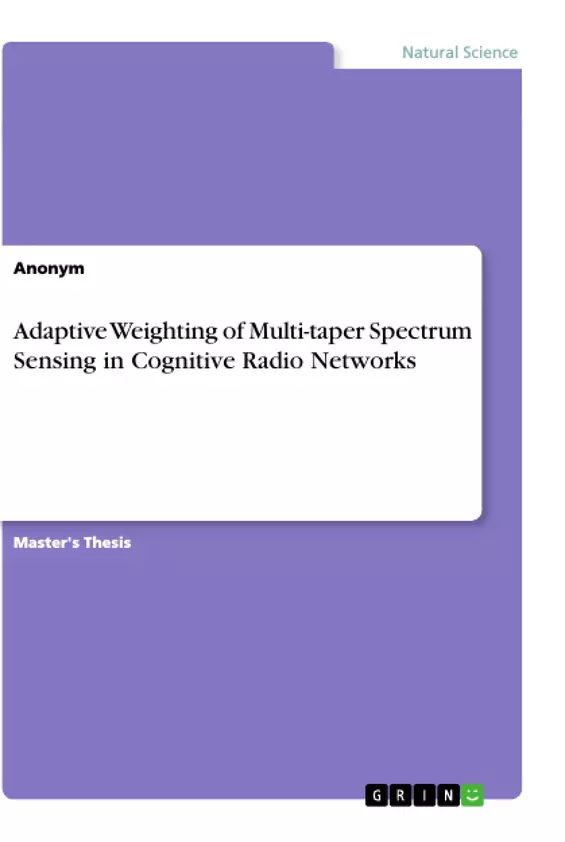This thesis discusses the performance enhancement of multi-taper spectrum sensing as a powerful technique for cognitive radio networks. In multi-taper spectrum sensing, regular detection of unused spectrum holes is performed to make cognitive radio networks aware of users' ctivities. As a result, more effective spectrum management is expected and unlicensed users could use unused spectrum holes.
In this thesis, an analytical study was proposed in which reliable, simple, and computationally efficient mathematical expressions for the mean and variance of the probability density function (PDF) of the multitaper spectrum sensing techniques were derived. The proposed analytical study was evaluated by intensive simulations using MATLAB. The presence of Additive White Gaussian Noise is assumed. Many important aspects of spectrum sensing in cognitive radio networks are included such as, receiver operating characteristics, detection rate versus signal to noise ratio (SNR), and the minimum required sample points for a specific performance. All simulations were performed to include most factors affecting the efficiency of the proposed sensing methodology such as, number of tapers (K), number of sample points (N), and the probability of false alarm (Pf). A comparison with energy detection method was done. All simulation results and comparisons confirm that the proposed model is reliable and robust under all factors considered in the simulation.
Inhaltsverzeichnis (Table of Contents)
- English Abstract
- Acknowledgements
- Summary
- Chapter 1: Introduction
- 1.1 Cognitive Radio Networks
- 1.2 Spectrum Sensing Techniques
- 1.3 Motivation and Thesis Outline
- Chapter 2: Literature Review
- 2.1 Spectrum Sensing Techniques
- 2.2 Multi-taper Spectrum Sensing
- 2.3 Performance Evaluation of Multi-taper Spectrum Sensing
- Chapter 3: System Model and Proposed Methodology
- 3.1 System Model
- 3.2 Multi-taper Spectrum Sensing
- 3.3 Proposed Analytical Study
- Chapter 4: Simulation Results and Discussion
- 4.1 Simulation Setup
- 4.2 Performance Evaluation of the Proposed Method
- 4.3 Discussion and Comparison with Existing Techniques
- Chapter 5: Conclusion and Future Work
Zielsetzung und Themenschwerpunkte (Objectives and Key Themes)
This thesis investigates the performance enhancement of multi-taper spectrum sensing as a powerful technique for cognitive radio networks. The main objective is to derive reliable and computationally efficient mathematical expressions for the mean and variance of the probability density function (PDF) of the multi-taper spectrum sensing techniques. This analytical study is then evaluated through extensive simulations using MATLAB, considering various factors such as receiver operating characteristics, detection rate, and minimum required sample points.
- Performance enhancement of multi-taper spectrum sensing in cognitive radio networks.
- Derivation of mathematical expressions for the mean and variance of the PDF of multi-taper spectrum sensing.
- Evaluation of the proposed analytical study through simulations under different factors affecting the performance.
- Comparison of the proposed method with existing techniques, such as energy detection.
- Assessment of the robustness and reliability of the proposed model in cognitive radio networks.
Zusammenfassung der Kapitel (Chapter Summaries)
Chapter 1 provides an introduction to cognitive radio networks, highlighting the importance of spectrum sensing techniques and the motivation behind this research. Chapter 2 presents a comprehensive literature review on spectrum sensing techniques, focusing on multi-taper spectrum sensing and its performance evaluation. Chapter 3 outlines the system model and the proposed methodology, which includes the derivation of analytical expressions for the PDF of multi-taper spectrum sensing. Chapter 4 presents the simulation results and a discussion of the performance evaluation of the proposed method, including comparisons with existing techniques.
Schlüsselwörter (Keywords)
The primary keywords and focus topics of this thesis include cognitive radio networks, multi-taper detection, AWGN channel, Receiver Operating Characteristics (ROCs), and Probability Density Function (PDF).
- Quote paper
- Anonym (Author), 2019, Adaptive Weighting of Multi-taper Spectrum Sensing in Cognitive Radio Networks, Munich, GRIN Verlag, https://www.grin.com/document/536407



